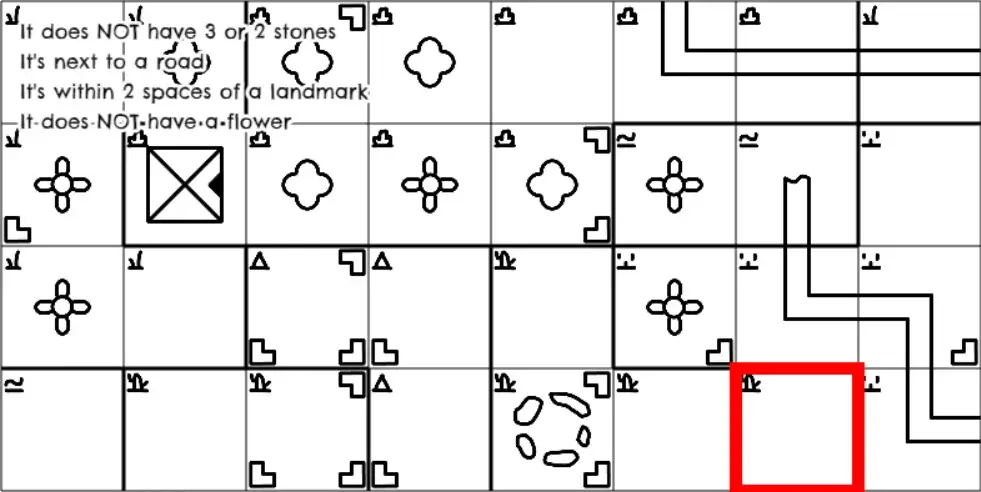
Deduction Boardgames (Part 1; Passive)
The past couple of years, more and more “logic deduction boardgames” have appeared. Most of them are very simple, yet have become wildly successful and popular.
Human beings are natural problem solvers, so games like this speak us and are easy to learn.
I’m interested in these games as well. Some years ago, I “invented” the idea of hybrid games: boardgames with an essential digital component, usually in the form of a smartphone doing some of the work.
(Obviously, I didn’t invent this idea. More and more boardgames use companion apps. I never officially published a boardgame in my life :p But when I made my projects it was still quite rare, and the techniques I use are different than what other games do.)
I already made a game that somewhat uses this technique: Wondering Witches
But the deeper we get into this, the more you’ll see how that project doesn’t really fit this genre or the techniques I will discuss.
So I thought: why not try my hand at creating such a logic deduction game?
This article chronicles my complete journey from start to finish. Figuring out algorithms, solving issues with them, displaying the results. I find that the best way to teach something and really show how it works.
I used the techniques discussed to create actual, playable, free boardgames you can find on my website.
- Pirate Riddlebeard (uses technique 1, in this article)
- Pirate Drawingbeard (uses technique 1, in this article)
- Pirate Spacebeard (coming soon, uses technique 2, from next article)
What are they?
Each player is dealt a unique card containing hints. During the game, players obviously may not communicate or show these.
Only when you combine all the hints, will they point to the solution to the problem at hand.
For example: in the game Cryptid you’re searching for a mysterious monster on a map. Each player has a card with hints like “it’s on a water or desert square” or “it’s at most two tiles away from X”. Your hints alone aren’t enough to find the right tile. But figure out the hints that other players have, and they will point to one unique square on the map.
You can approach this idea in two ways:
Passive: use a fixed map, let the game pick a location, then generate hints that uniquely point towards it. Players are merely figuring out the answer.
Active: allow players to change the map to make it conform to whatever hints or instructions they have.
You can also choose how mathematically precise you want to get:
Precise: all hints point to exactly one solution, no hint is unnecessary
Intermediates: there are intermediate goals that add an extra layer. For example, the map might have multiple small hidden treasures. Some hints point to their location, while other hints say something like: “the big treasure is 2 tiles from a small treasure”
Fuzzy Solution: there might be multiple solutions, which can make the game easier or harder* (depending on the rest of the gameplay).
Fuzzy Hints: add unnecessary hints to add some chaos into the mix, makes any game much harder, but also more frustrating
Chaotic: fuzzy hints, fuzzy solutions, and players might even be able to change these.
*At first, you might think multiple solutions make the game easier. You don’t need to be as precise, you maybe don’t need all the hints, to find a correct solution. But on the flipside, you’ll never know when you’re done. Let’s say there are 10 possible locations left … are they all a solution? Or are you simply missing one hint? The extra uncertainty will often make games harder instead of easier.
What am I going to do?
I’m going to program some algorithms to create solutions and unique instruction sets that point to them.
I’ll talk about how I approach a problem like this, how I solved it, what different techniques you might use.
I’ll do this using JavaScript and the Phaser framework. (As I did with all my other games. It means you only need one smartphone with a browser + Wi-Fi to play a game like this. No need to install an app.)
And I’ll use these algorithms to design two game ideas I had. At this point, I’m not sure if that game is going to work or be fun at all, but it’s always good to have a practical goal in mind when working on tough problems like this. To have some context for what you’re doing.
(All my board games can be found here: Pandaqi Boardgames. To view their code, simply open the inspector and view the JavaScript files. Nothing is hidden, it’s all standard website stuff.)
Why are they so interesting?
I see several reasons why these games are so well-liked.
Reason #1: Humans are problem solvers. It just happens automatically. This is also why clickbait is so effective: once a story is started … we just need to know how it ends. Once a question is asked, we just need to know the answer.
A question as simple as “which location on the map has the treasure?” is enough to engage anyone.
Reason #2: Everyone is constantly active. Because everyone has a part of the solution, you have to pay attention and stay focused all the time. Each turn impacts you directly. Games like these regularly ask players to say if they agree/disagree with the current solution based on their unique hints (even if it’s not your turn at all).
Reason #3: Humans like a sense of ownership and individuality. By owning a unique set of hints, which only you know, you feel more valuable and powerful as a player. And that feeling is completely deserved. You are essential to the game.
(The exact hints for a scenario depend on player count, for example. Changing from 3 to 4 players will completely change what hints are doled out.)
Reason #4: Easy gameplay. Because all the complexity was done beforehand, by creating the actual scenario, the game itself is very easy to learn and play. It usually involves a handful of actions for asking information in a specific way or adding/removing anything from the board.
(The details of these actions are what make the game, and are often highly thematic and intuitive. For example, in “Search for Planet X”, you try to, well, find the mysterious planet X in a universe built from 18 sectors. Almost all your actions are simply about picking a range of sectors and asking what’s in there.)
Approach #1: Treasure Hunting
I’m drawn to the idea of adding more “gameplay”, more interactivity and chaos to these games. But that’s obviously really hard and experimental to do.
So let’s start with the simplest core variant: a passive precise game.
And let’s use a very straightforward theme: treasure hunting.
There’s a map of square tiles. Each tile has a terrain: grass, water or sand. Each tile can have a landmark: a building of height 1 to 4. Each tile can have nature: trees, shrubs.
We can just randomly generate one for this purpose. And then we randomly choose one tile to be the location of the treasure.
Most algorithms can be written in two ways: forward and backward. We’ll explore both, but first we need to determine what “hints” even mean.
Hint Types
Hints are simply any statement we can think of that tells you some bit of information about a location on the map.
So we have hints for terrain (“the treasure has terrain X”, “the treasure is NOT on terrain Y”), landmarks, nature.
Hints can be about the tile itself, but also its surroundings. (“The treasure is at most two tiles from a landmark”, “there are 3 landmarks in a radius of 3 tiles from the treasure”)
As long as they don’t become too complicated, or their numbers too high, any of these ideas are fine.
Generating Unique Hints: Backward
It’s the simple but naive approach: we generate a random set of hints!
We start with hints, then work backward to end on a location.
For example, with 4 players, we say 4 hints each. This means we generate 16 hints from that list of possibilities. Completely randomly.
Then we check these hints against all locations on the map to find which locations comply with all these requirements.
It might be 0. It might be 10.
We’re happy if we find exactly 1.
Problems & Solutions
There’s one terrible issue with this: the probability of stumbling upon a perfect solution is terribly low.
Problem #1: hints might contradict each other directly.
Solution #1: Don’t allow this. If we already have a hint stating “the treasure is in the water”, we don’t generate any more hints saying the treasure is in some other terrain.
Problem #2: hints might all be “samey”. They might all talk about terrain and landmarks, and not a single one about nature, removing whole parts of the game.
Solution #2: divide the hints into categories. Force the algorithm to cycle through all categories when picking hints.
Problem #3: if a solution exists, we’re likely to find multiple.
Solution #3: pick one solution as “the real one” (preferably the one furthest away from all the other solutions, as it’s least likely to be influenced by them), change one aspect about all the other locations so they don’t fit anymore.
Alternative Solution #3: keep adding more hints to exclude the extra solutions, until one remains.
Optimization
While implementing, I figured out a huge optimization that also mitigates the problems above.
Instead of generating all hints at once then checking them against all cells …
… we can generate hints one at a time, and strike off any location that doesn’t fit as we go.
It’s a simple loop:
We create a random hint.
We check it against all locations and save the ones that are valid.
Repeat for each hint, shrinking the list of possible locations as we go.
Once only one location remains, we stop. (If none remain, or we’ve exceeded some maximum number of hints, we just stop and retry completely.)
Why is this so much better?
The list of locations only shrinks over time. Only the first hint is checked against the whole map. The second one is only checked against whatever remains, and so on.
Instead of checking 16 hints against 128 squares ( = 2048 checks), it’d be like
1 hint against 128 squares
1 hint against 50 squares
1 hint against 12 squares
“Hey, only 1 square remains, solution found!”
This also reveals the second benefit: if a solution exists, we’ll find it as quickly as possible (with the minimum number of hints).
Below was the first map I received after creating this system, and also the very first one that actually provided a solution. (I’m writing this section “in the future”, because it took me a few days to realize this optimization. So don’t worry, I’ll explain more about this map later on.)
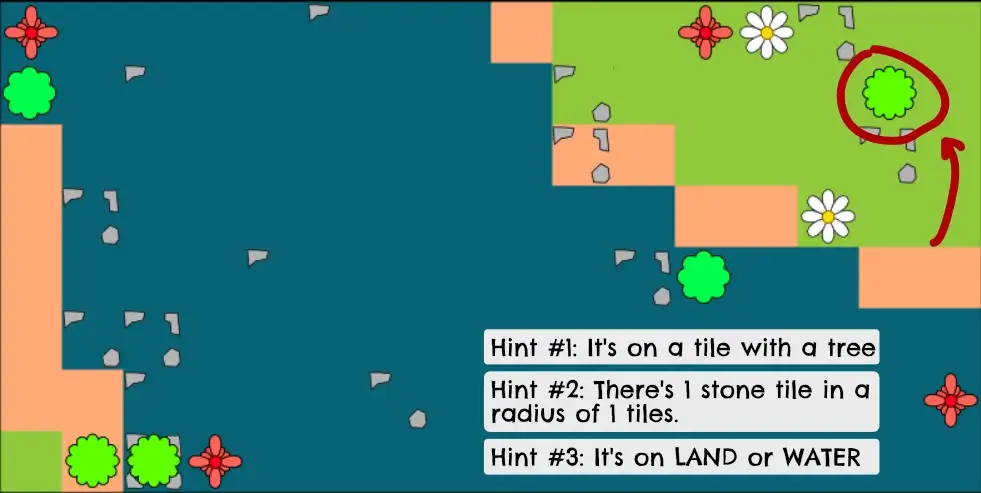
So yes, this works great. We now have proof that this technique is viable. It’s also very, very fast to compute.
The problem is that it only renders a solution once every 10-20 tries, and they are often very stupid. (Like, only a single ridiculously specific hint is needed to find the location.)
Being such a fast algorithm, though, this still means we get a solution within 50 milliseconds.
Here’s the next one it generated. Play for yourself! Find the single tile that fits.
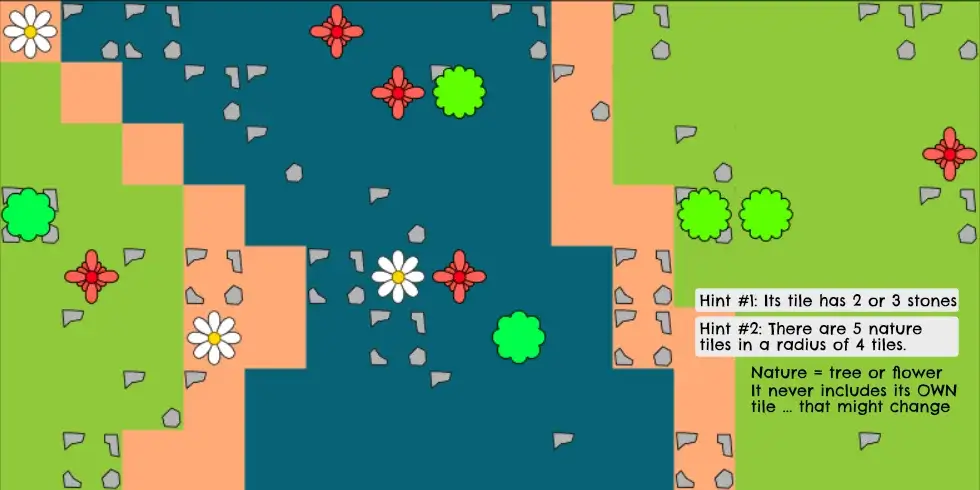
But let’s not get ahead of ourselves, read on!
How’s that?
It’s a very imprecise algorithm. You’re not certain to find a solution, and finding a unique one is even harder.
If you’re lucky, you’ll find a great solution in 1 second, with very little code. If you’re unlucky, the computer might be thinking for 5 minutes and still come up empty.
But let’s see it in practice.
First Try: no solutions were generated at all. The hints were too specific and too wild.
For example! Hints like these regularly appeared: “There are 5 landmarks in a 1 tile radius.” This simply isn’t possible. In a 1 tile radius we can have at most four landmarks (one on each neighbor).
Conversely, a hint like “there are 0 landmarks in a 5 tile radius” is unlikely to be true, as that’s a very large area to cover without finding any landmark.
But that isn’t the biggest issue with hints like that. It’s that those hints are very precise. There’s no leeway, no wiggle room, any tile with 4 or 6 landmarks around it won’t cut it.
The same issue is present in all other categories, which, when combined, means the computer never finds a suitable tile. No matter how hard it tries.
(All other parts were working fine and efficiently within an hour or two of coding. But even when I only used 1 hint it often wouldn’t find any suitable location with this system.)
How do we fix this? We need to change hints to things like this:
Multiple options: “It’s on terrain X or Y”
Thresholds: “There are between 5 and 8 trees around it”
Greater/Less than: “It has at most 4 landmarks in a 3 tile radius”
How? In the hints I store a “secret parameter”. This is the “random offset” from the real value that we used. This way I can easily check if a location fits the hint: <real number> + <offset> should be the value shown in the hint.
(I also sense I should’ve focused on terrain much more. By adding more terrain types, the map becomes prettier, and these hints more diverse.)
Second Try: Better Hints
I removed all hints that were just stating an exact piece of information, like “the treasure is on terrain X”. Just never a good idea in a game like this.
I rewrote other hints to be more vague. And I invented some extra hints that I thought were nice, like “terrain diversity” which counts how many different terrains are around the treasure.
For that to work well, I had to bite the bullet and implement more terrain types into the game.
I also had to step away from the idea of a “realistic pirate map” (with islands and water around it). This leads to terrain that is too uniform (big blobs of identical terrain), and I obviously can’t place structures or trees in the water, eliminating half the map before the game even started.
I realized that it was basically becoming more and more like the game Cryptid. (And in doing so also learned why they designed that game the way they did :p)
I’ll have to worry about being different from that game at a later stage, for now I just want to get a working algorithm. (We’re already quite different due to how maps are generated, the variety of hint types, and the fact players can have more than one hint.)
For now though, I’m focusing on the better hints.
I only changed the visuals to make it easier to see for me when debugging. I realized I needed to draw everything from above, and needed easy icons so players could easily draw them themselves. This resulted in …
Nature can now be a tree or a flower.
- (Easy to distinguish and draw for players.)
Landmarks are replaced with stones: there can be 1 to 4 stones on a single cell.
- (How do you draw top-down houses that can have 4 different heights? I didn’t know, so I changed it. Also, the stones are drawn in such a way that there can also be nature on that cell.)
How’s this?
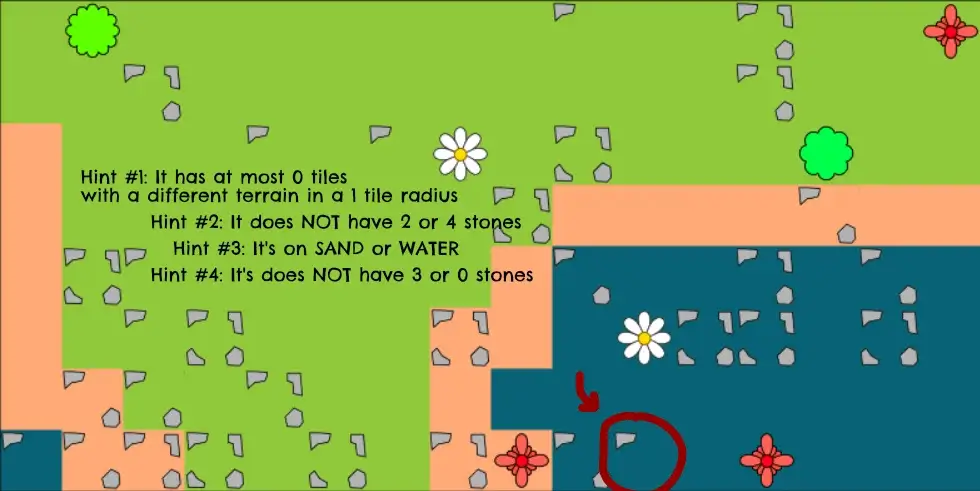
(Obviously, I need to change the numbers so we don’t get “at most 0” or similar situations. That’s a small fix. I also need to tell certain hints (such as “NOT X or Y stones”) to only appear once.)
The system is already quite powerful! Here’s the next one I generated after these fixes, play it for yourself.
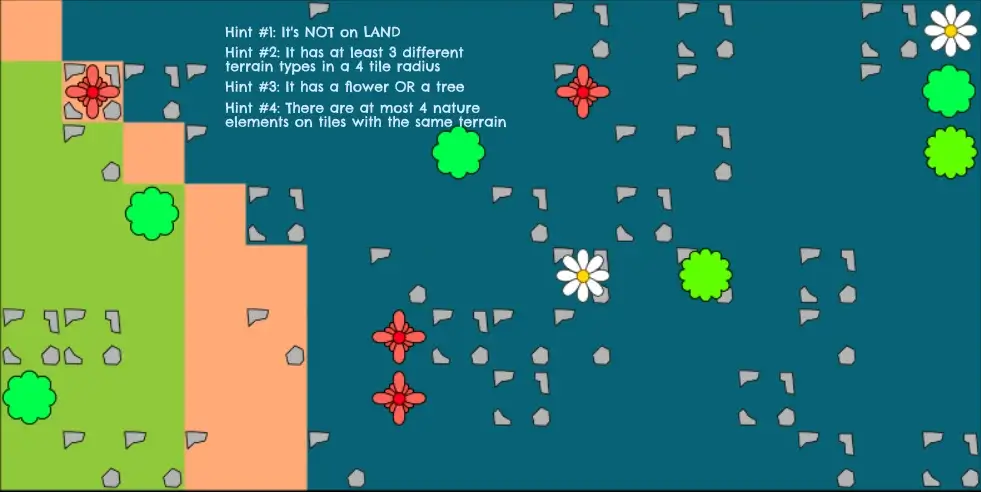
(Solution? The one sand tile with a flower.)
Better, but not good enough yet.
The most important element of a game like this remains the map itself. If it’s not varied enough, or too symmetrical, or has other clear issues, then you will never find a good set of hints leading to a unique location. So let’s completely focus on that now.
Third Try: Better Maps
I spend some time writing a better generator for the maps.
For example: ensure terrains are well-balanced (count terrains, none of them is allowed to have too few or too many tiles).
I considered changing to hexagons (more connections per tile, more intuitive way of counting distances). But I want to keep it as simple as possible. And I usually make games people could play with a piece of paper, and those are still very much a rectangle.
But I just wasn’t happy with all of this. The problems with this type of map just kept stacking up.
So I completely changed the kind of map and how we generate it.
I invented 6 terrain types: water, grass, desert, mountain, swamp, and snow.
At the start of generation, I place two or three dots of each terrain randomly on the map.
Then I “grow” these one tile at a time …
… until every tile on the board has a terrain!
The growing ensures terrains come in nice groups/chunks. For each terrain, I’ll draw a slightly different sprite for trees and such. (Example: desert gets a cactus.) And the water terrain can’t have nature or stones.
We lose the “natural” or “realistic” look we had, but in return get a map that’s way more diverse and suitable for a game like this.
Simply by adding more terrains, we already get things like this:
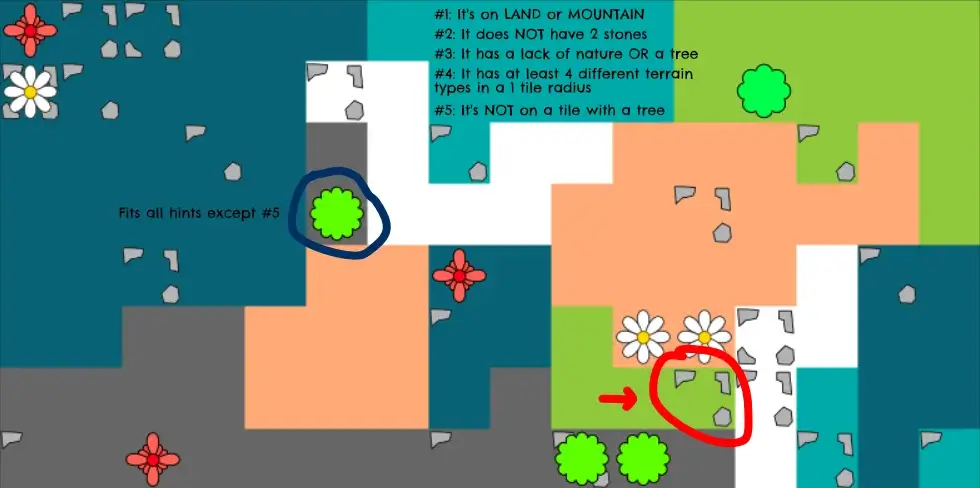
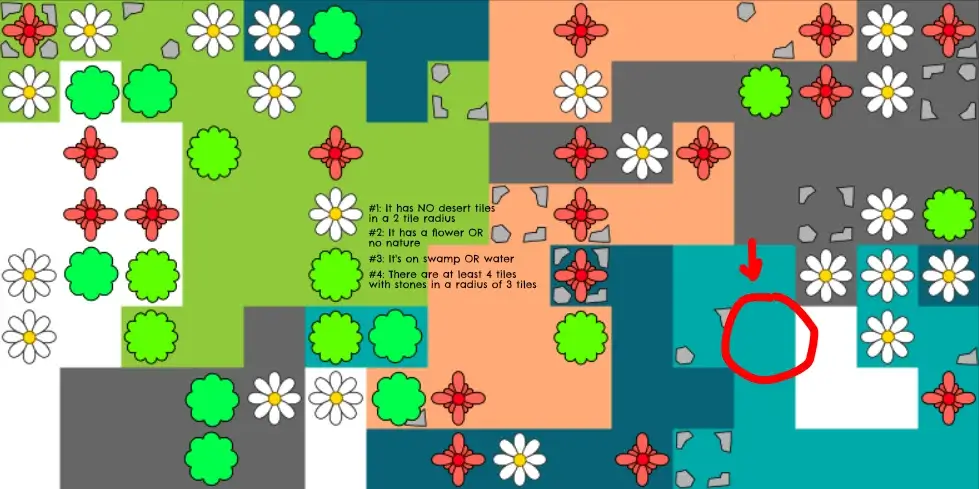
Two issues remain:
The placement of other elements (stones, nature) is very bad and ugly.
Some hints are clearly “more valuable” than others
At this moment, I don’t see an easy way to fix the second issue. That’s the problem with the backward technique: we start with random hints and just hope to end up somewhere. Some of those hints might not be amazing.
The first issue is a matter of experimenting with how I want the maps to look and putting more effort in the drawings.
Final Version
I’ve learned over the years how important it is to have really unique elements in a project, that only appear (or make sense) sporadically.
It just gives a more human and memorable touch to the game, to the things it generates.
As such, I decided to finish the maps in this way. All elements below are optional, they might be present:
Add only one or two “special buildings”.
Add a “road” or two. This is just a random walk through the map.
One pirate ship, in the water.
When not present, it simply removes all hints related to these things, so they’re not generated.
There might be games where the road(s) or special building(s) don’t matter at all. But you don’t know beforehand, so they are still an important part of the game. And they definitely make maps looks more interesting and diverse.
I heavily scaled back how much nature and stones are placed, and placed them in tighter groups.
I also thought more about incorporating the algorithm in a full game in the meantime. Which made me realize how we needed a waaaay smaller map and a completely black-and-white version that’s easy/quick to copy to your own paper. (I talk about these things in the devlog for the game this ultimately became: Pirate Riddlebeard.)
So this is the final version:

It generates the full game within less than a second. Never fails, works everywhere.
It does need many retries: at least 10 or 20 in most cases. Most of that number comes from the map generation. As such, it’s way more likely that generating the random map will fail (due to constraints I set that should keep the game balanced), than our backward hint algorithm failing.
But because the calculations are relatively simple, the maps small and simple, this should be no problem for any modern device to do in a fraction of a second.
Generating Unique Hints: Forward
The forward approach, as you’d expect, moves in the opposite direction.
We start by choosing a location, then go forward with that to collect all hints pointing to it.
Initially, this may seem preferable to the previous approach. The obvious better and cleaner solution!
Problems & Solutions
That’s true … for the most part.
Picking one location and generating all hints is easy to code and fast to execute. You just run through all hint types you invented, calculate what they should be, and save that.
You’re also certain they won’t contradict each other. And you are certain the hints have at least one solution.
The next part is hard, though.
Problem #1: this results in loads of hints. Most of which are just slightly different from others. (“The treasure is at least 2 tiles away from water”, “The treasure is at least 3 tiles away from water”, …)
We can’t give each player 50 unique hints :p
Solution #1: Hints with a number should just pick a random one, though preferably near the “extreme” to keep the hints tight.
Hints with discrete options (such as a specific terrain) should bundle them: the treasure is NOT in water OR grass.
Problem #2: the hints might still point to other solutions as well. Or, more likely with this many specific hints, it might too obviously point towards the treasure.
Solution #2: you can actually solve this in a way that almost entirely solves problem #1.
Repeat this loop:
Check your current set of hints against all locations.
Only find one solution? The hints are too narrow, remove one at random.*
Find multiple solutions? Stop! The previous set of hints was perfect.
*Instead of random removal, it’s probably better to alternate between categories again. Ensures hints are nicely distributed and stay unique to one solution as long as possible.
The only reason we don’t do this (instead of solution #1 as well) is because it’s very expensive to calculate all this. We want to have a reduced list of hints before doing this loop.
Implementation
I already had all the code for maps and hints from the backward technique.
There’s one big difference I had to figure out.
In the backward technique, we fill in random numbers. When we check a cell, we fill in the same random numbers, but overwrite anything specific to the cell.
In the forward technique, we want create a unique hint for each possible combination of numbers.
Let’s say we have a hint of the form: “There is X nature within a radius of Y tiles”
The radius (Y) is a number we need to fill in ourselves! (The value (X) is what’s being calculated for the specific cell.)
We need to specify the range such a number is allowed to go through.
And then we need to write a loop to create a unique hint for each of those values.
In this case, I might say “the radius must be between 2 and 4”. Which should result in 3 unique hints: “there is X nature within a radius of 2”, “there is Y nature within a radius of 3”, and “there is Z nature within a radius of 4”
How’s that? First try
As expected, it’s more robust and streamlined than the other approach, but also much slower.
With my current set of hints (~6 per category, three categories), on average, …
Generating everything yields 130 hints
Whittling it down takes 1 second
Which means we end up with 5-15 hints
As you can see, it takes longer, and leads to bigger instruction sets than the backward technique.
Here’s an example, made using the old visualization of the map. (I developed the forward and backward algorithms parallel to each other, for some time.)
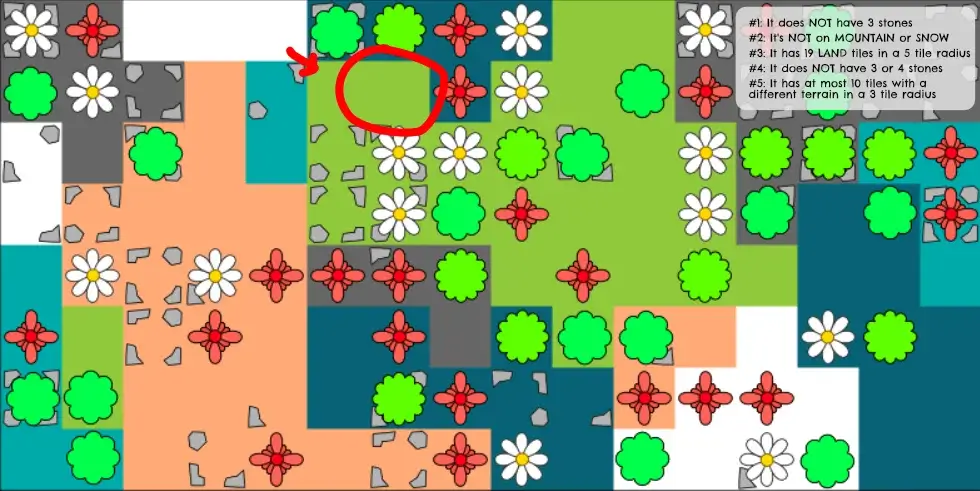
We see that some hints are just too specific and hard. (19 tiles in a 5 tile radius!? Let’s shrink the maximum radius on that one!)
We also see a duplicate on the “NOT stones”.
Second Try
Let’s add the improvements and see what we get:
Lower the radius on many hints. I think 3 tile radius is a clear maximum, and maybe even that is too large.
On hints that have many variants, randomly remove half of them before we even start whittling down the list.
- (Example: “it’s not on TERRAIN A or TERRAIN B”. There are loads of 2-terrain-combos on which the treasure is not. But we only want this hint to appear like once or twice, and it doesn’t matter much which combo we pick.)
Add the margin of error. When a hint says “at most 2 tiles”, it currently just means “exactly 2 tiles”. When generating hints, I need to add/subtract from numbers to create that margin of uncertainty.
Alternate categories when removing hints. (Or you might end up with 10 hints all about nature and nothing else, which is rarely what you want.)
But, when I was ready to test this … I realized I was being stupid. Well, I was being stupid about one of these points.
We can do the same thing as we did with the backward technique!
Add 1 hint at a time (from the list of all the possible hints, which we just made), until our hints only point to one location!
(We are certain this will happen at some point, as all our hints point to exactly one location, and any other solutions are just accidental.)
What does this get us?
The reduced list of hints is ~50 long
It usually finds a solution first try, within a fraction of a second
(I’ve already restricted it to keep the number of hints at a nice length; 1-2 hints per player.)
Below is the first map generated this way:
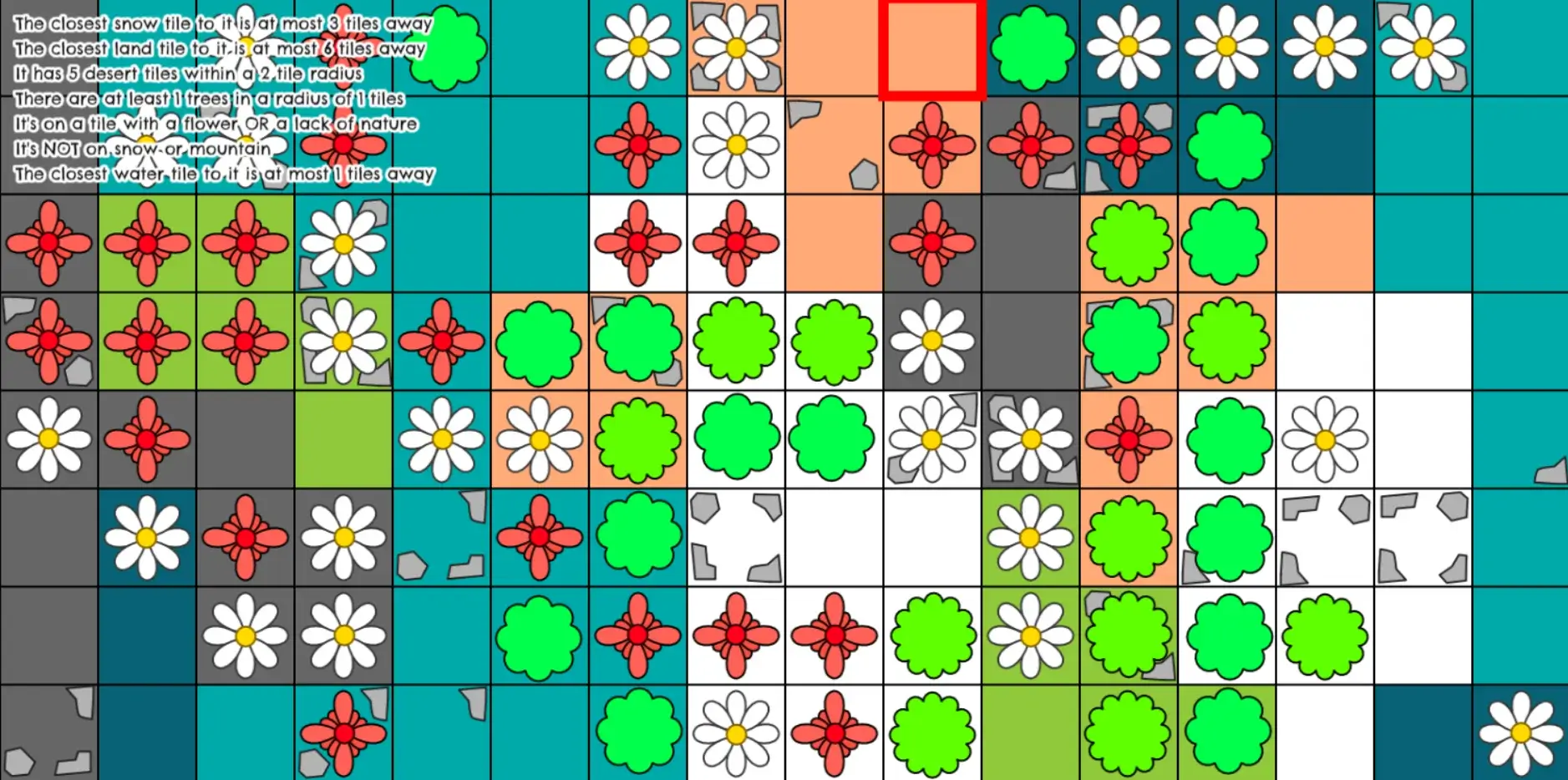
Pretty nice. Hints seem equally valuable, but also not too specific. It can generate these really quickly, and they are always really different.
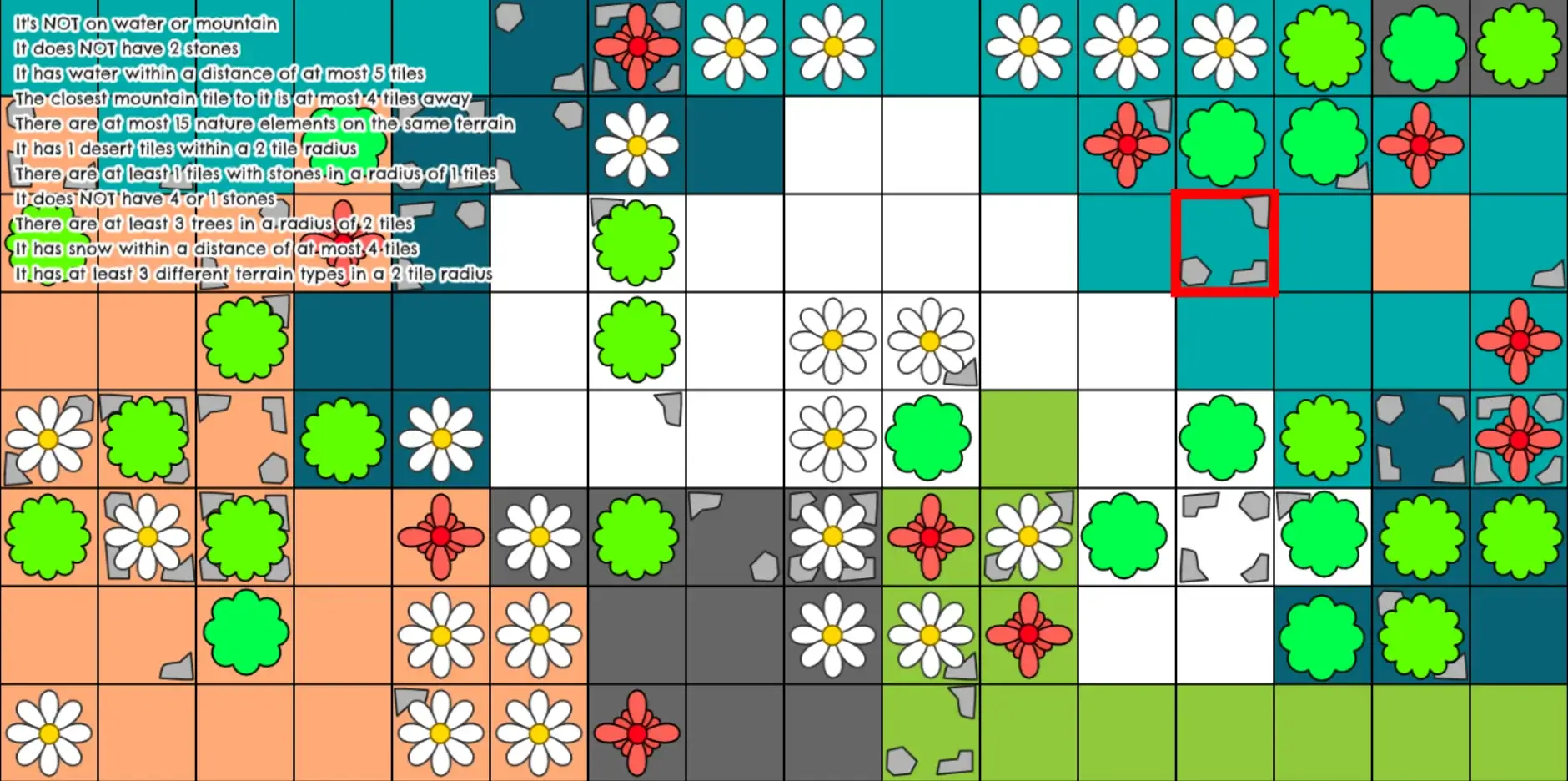
Every hint has some value. For example, “there are at most 15 nature elements on the same terrain”. This is true for all terrains … except desert ( = orange). It actually has 16 squares with nature on it.
Compared to the backward algorithm …
I had more trouble implementing it. (It’s way harder to generate a list of all valid hints than to put in random numbers.)
It finds a good result on first try, without retries, 99% of the time.
It leads to larger sets of instructions.
It feels a bit wasteful/useless to generate all hints and then just remove almost all of them in the blink of an eye. I don’t really see the benefit. In practice, I don’t see this algorithm generating more unique/varied instruction sets than the backward version.
- Unless you want to create a game with special requirements: irrelevant hints, non-unique hints per player, like loads of hints spread all over the place. In that case, the forward algorithm gives you easy control over that.
But I really don’t want to continue until I’ve fixed the absolutely ugly maps we’re getting now, so let’s work on that first.
Third Try
This is what its final maps look like:
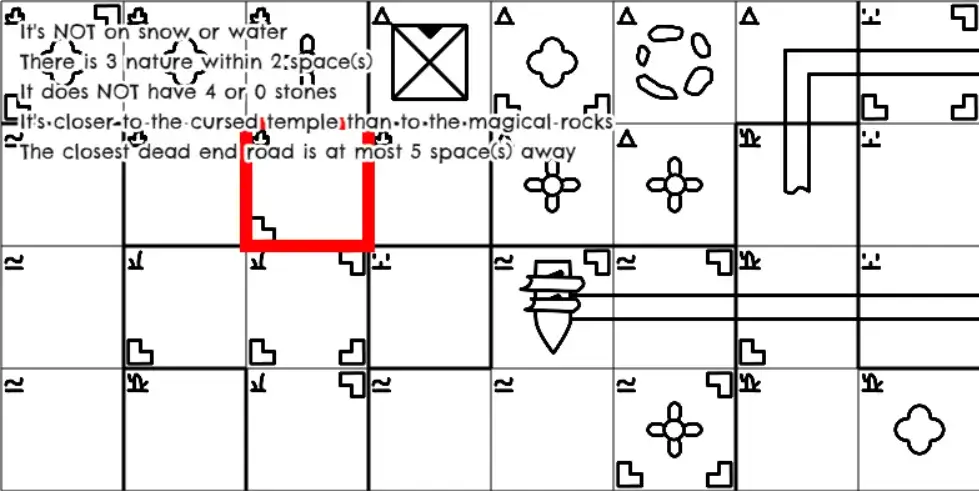
As you can see, you can’t really distinguish it from the final results of the backward algorithm.
Behind the scenes I can see that generation often doesn’t need retries and is thus quicker/more robust.
For example, the map needed 11 retries to be formed, but the hints were perfect first try.
But besides that? This algorithm feels like it’s a cleaner and better method, but in practice I don’t see it as a clear winner over the “backward” algorithm. It was way harder to implement and we need to throw away many of the hints anyway in the end.
How to apply this in a game?
Using the forward technique (with some improvements), we’re able to generate many different scenarios for any given map: a treasure location and a set of hints (unique to each player) leading to it.
But that’s not a game. Not yet. It’s just the underlying structure we need.
Now you need a way to show the map, show the hints, and gameplay to help with deducing the solution.
In these games, gameplay is all about communicating information in a way that is always helpful, but also always vague. (As players are not allowed to just tell their hints, but you still need to figure them out somehow.)
First some practical considerations.
Once you have this algorithm that generates solutions, you can make the game completely analog/physical:
Create some custom maps that look nice and print those.
Create hint cards with the hints printed on them. Clearly indicate the player count and scenario number on them.
Or you can keep it a digital, free game like I usually do:
Let players generate random maps themselves and print them. (Or show them on an iPad in the middle of the table, if they’re so inclined to remove the physical board from boardgames :p)
Pass the phone around the table. It shows the unique hints for each player, so they can write them down on a piece of paper.
(I use a “seed” for the random generation, which is just a random string of letters, like “HUNT”. This way, players can always replay their favorite maps, for example.)
Then the gameplay.
As it’s a game about treasure hunting, something like the rules below seems sensible.
Your main action is digging. Pick a square, dig there. All players around the table tell you if that square is valid: if it contradicts any of their hints, it’s not.
If all players agree, you found the treasure! If not, place some marker there to indicate it was wrong.
(You could make it harder by hiding the information. Don’t say “I agree/disagree”, give players cards for that. Each player places their card facedown in a pile, it’s shuffled, then revealed. If that pile has at least one disagree-card, you know it’s not the treasure location, but you don’t know who disagreed.)
This is not enough, but it’s a start. Ideas for improvements:
Each player has a character. You can only dig where you are. Moving is another action, where you stand determines any bonuses/penalties.
There are those “small treasures” on the map. It would keep players happier by achieving small successes along the way, as well as give its owners money they can use to do extra stuff.
There should be ways to directly trade or reveal some of your hints.
There might be a more general digging action, in which you ask questions about an area of multiple tiles, but only one player gives you their answers.
Being pirates, players are allowed to LIE. To keep it controlled, though, anyone who lied during a round must reveal this at the end.
In short, use that “treasure hunt/adventurer/pirate” theme to spice up the game and add a second system to make it all more interesting than just running the numbers in your head.
By digging somewhere, players reveal that they think it’s a nice location. If digging is completely free, however, players will just do it willy-nilly and often pick wrong locations to throw off other players. If you could somehow make digging more expensive, harder to execute, it incentivizes players to be more strategical about it.
Just some ideas. As long as you have a working system behind it using these algorithms, you can do anything you want.
Update: generating hints of equal value
We’re one week further now. I’ve developed the algorithms above into a full game that’s completely playable. In doing so, I did receive confirmation that not all hints are created equal and that this is a problem.
For example: I’d often get maps with a hint like “the treasure is next to a landmark”. But then the map only had one or two landmarks, meaning you already narrowed the treasure location down to like 4 or 5 squares. Just from this one hint. While another player might get “it’s NOT on desert” and still has 20 possible squares to choose from :p
Then I realized: hey, we can actually solve this quite easily. (It’s just going to be a bit expensive to calculate.)
Once we’ve generated the hints, calculate their “impact” (per player). For example, let’s say Player 1 has 2 hints.
Start with a list of all locations
Remove those that don’t comply with hint 1
Remove those that don’t comply with hint 2
Count how many possible squares are left over.
Ideally, each player has roughly the same number of possible squares when looking at their hints only.
After calculating these values, we compare them. And if the difference between the players is too big, we fail the hint generation and try again.
Doing this also gave me some interesting information, which I should’ve had a week ago :p Namely: how many options are actually left for a player at game start?
This turned out to vary wildly, as I suspected. Many games had something like two players with ~5 spaces left, and others with ~25 spaces left.
I added the following restrictions:
There may be no more difference in spaces left (between players) than 33% of the map
At least 25% of spaces must be left
At most 75% of spaces must be left
Why? I started with restriction #1 and numbers that felt sensible.
That was too strict: generation took way too long. It also wasn’t always great, because it could lead to games where every player only had ~5 possible spaces left. (Or all of them had hints that only ruled out like one specific square :p)
So I added the second two restrictions. And then I relaxed the numbers a bit until I consistently received results within a second.
Below is the first map made that way:
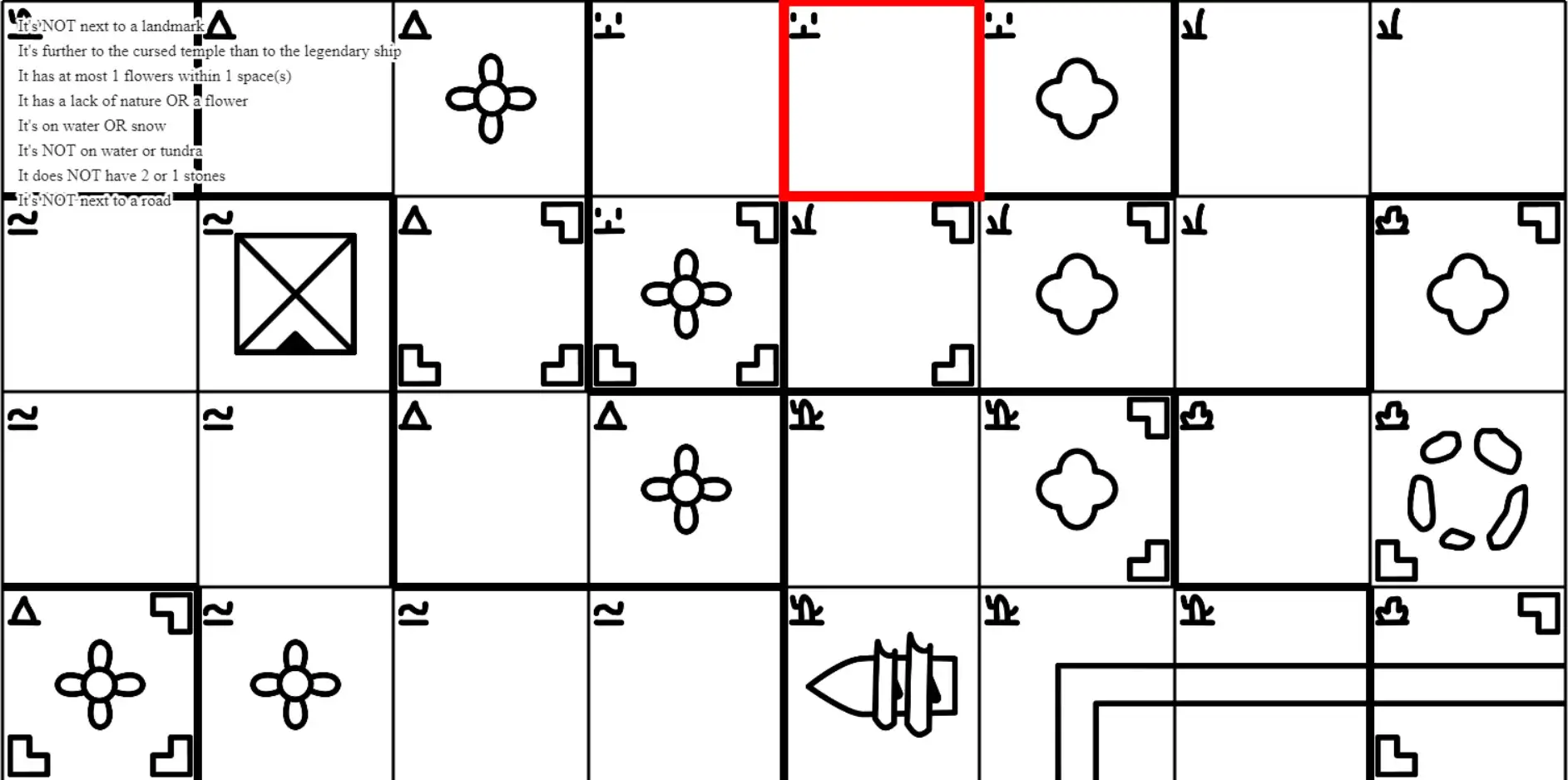
It’s still not perfectly balanced. That only happens some of the games. But the starting options for the players (with this particular game) were: [18, 18, 12, 8].
So player 1 had 18 options at game start, player 4 had only 8. Yes, slightly unfair games can happen.
But most of the time the numbers are all around the ~15 range.
And the advantage isn’t as big as you’d think: yes, you have fewer options to consider right from the start, but it also means that other player’s hints are more vague and thus harder for you to discover.
(Technical note: there is a check within the loop that tracks how long we’ve been trying. The longer it’s been, the more these numbers are “relaxed”. It’s more important to me that the generation never gets stuck and always returns a game within a reasonable amount of time.)
Here’s one last map to finish this part of the article! Starting options are: [18, 20, 10, 13]
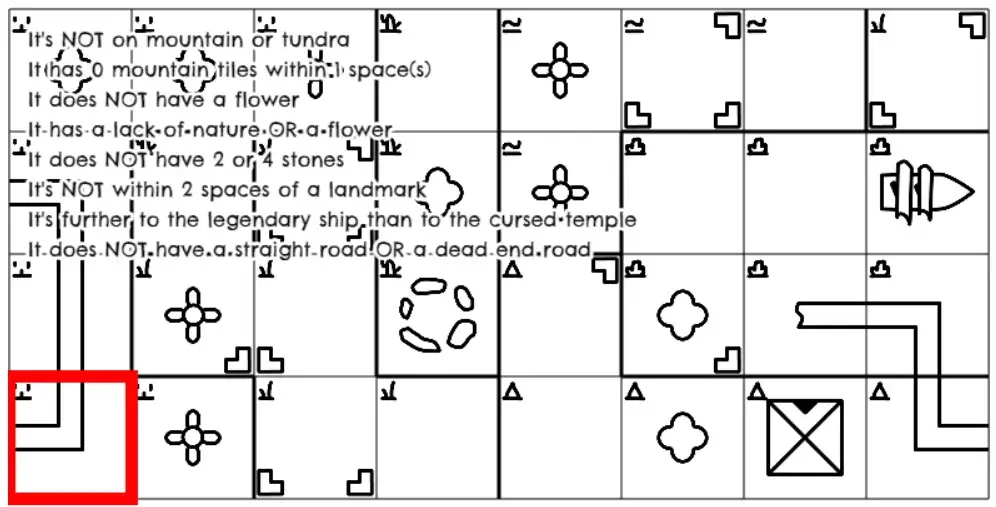
The other approach
This article became quite long, and the games I made from it ended up completely different and separate.
As such, the second approach (the active one, where you actively change the game state to match certain hints/wishes), has its own article: Deduction Boardgames (Part 2; Active)